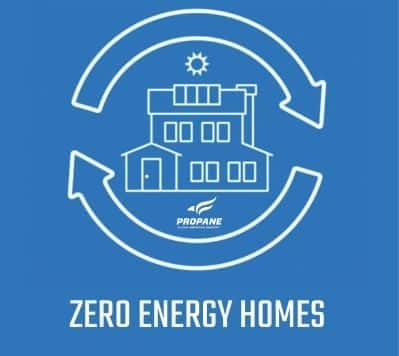Zero Net Energy & Zero Energy Ready Homes
The future of homes is all about sustainability. Interest in Zero Net Energy homes is increasing, which presents homebuilders with a new challenging set of construction decisions. How can you incorporate green home designs, technologies, and energy-efficient appliances? By utilizing propane, you can have all three.
What is a Zero Energy Home?
A Zero Net Energy home (ZNE), also referred to as a Zero Energy home, produces as much energy as it uses. You can achieve ZNE home status by increasing a home’s energy efficiency and adding a renewable energy source such as solar to offset the home’s remaining energy consumption. Zero Energy Ready homes (ZER) are built with the same efficiency features and are equipped to add a renewable power source like solar to offset electricity usage from the grid.
How Common are Zero Energy Homes?
ZNE homes are becoming more popular every day. In fact, more than 22,000 zero net energy projects are either in design, construction or completed, according to Team Zero.1 A survey performed by Harris Insights & Analytics for PERC found that 83 percent of homebuyers and 89 percent of builders are likely to consider a ZNE home for their next purchase or build. And about the same number are very or somewhat willing to pay more for a ZNE home. According to the Rocky Mountain Institute, the potential market value for ZNE homes is projected to be $33 billion by 2037.
How is Energy Usage Measured?
It’s important to ensure your customers understand the difference between site and source energy when working toward an energy-efficient home strategy. Site energy measures only the energy used at the house and doesn’t account for upstream losses or energy production, which is why it’s known to be less accurate. Source energy is a more accurate measurement. It measures energy use starting at the source, including the energy required to extract and process fuel.
What is a HERS score?
The Home Energy Rating System (HERS) Index is used to measure efficiency. The lower the score, the better. ZNE homes have a score of zero and typical homes have a significantly higher score around 100.
How Propane Can Help?
A common misconception is that ZNE and ZER homes are all-electric. In fact, mixed-fuel solutions are popular in this type of project because they give homeowners the opportunity to lower their monthly utility bills while still reaping the benefits of gas. Mixed-fuel systems typically offer lower first costs and reduced ongoing energy costs and emissions, and they allow for hybrid systems tailored to a project’s unique needs.
Achieving ZNE doesn’t mean giving up desirable and high-performance gas systems. Propane is a clean alternative fuel and can be used nearly anywhere, including beyond the natural gas grid. Propane is often used in ZNE and ZER projects to power furnaces, backup generators, water heaters, fireplaces, and cooktops, and other high-efficiency appliances, helping builders and homeowners achieve energy-efficient living.
For instance, ground-source heat pumps are traditionally very efficient, but also have very high first costs. Based on a detailed heating systems analysis performed by the Propane Education & Research Council (PERC), a ground-source system for a typical sized home would cost almost $35,000, compared with around $11,000 for a high-efficiency propane furnace. So while the ground-source system was found to produce cost savings, the magnitude of these savings in a high-performance home with much lower loads would be smaller and extend its payback period significantly, potentially beyond its service life.
When analyzing source energy ratios, propane wins hands down. Data based on national averages shows that it takes 3.03 units of energy to produce and deliver one unit of energy in the form of electricity to a home, versus just 1.15 for propane.
In addition to increasing a home’s energy efficiency, propane appliances produce much fewer emissions, which is important to any builder concerned with their property’s carbon footprint. For instance, a propane tankless water heater reduces emissions by 67 percent compared to an electric storage tank model.
To maximize a ZNE home’s energy efficiency and lower its HERS score, here are three things you can do:
- Focus on the building’s envelope. Achieving ZNE goals begins with reducing the loads on the building and focusing on building envelope priorities such as insulation quantity, air sealing, window performance, and house orientation.
- Include high-efficiency propane appliances. Larger home systems generally consume significant amounts of energy. Water heaters, furnaces, and generators should be the first to transition to high-efficiency propane appliances. Propane can also power several other high-efficiency appliances throughout a home, including kitchen ranges and ovens, fireplaces, space heaters and clothes dryers.
- Trim other energy use. Energy Star appliances, LED lighting, and energy monitoring devices can help further cut a home’s energy consumption.
Incorporating propane appliances into a ZNE build significantly lowers a home’s energy consumption, making it easy to achieve sustainability goals and deliver premium performance to homeowners. For homebuilders, building ZNE homes could be a great way to differentiate your company from other builders and take your homes to the next level, helping you get more bids and more business.
To learn more about building with propane, visit the commercial page.
Sources
1 https://drive.google.com/file/d/11avRaT6nRgZQmt4BzMZ2vycCBVVBvuP3/edit
